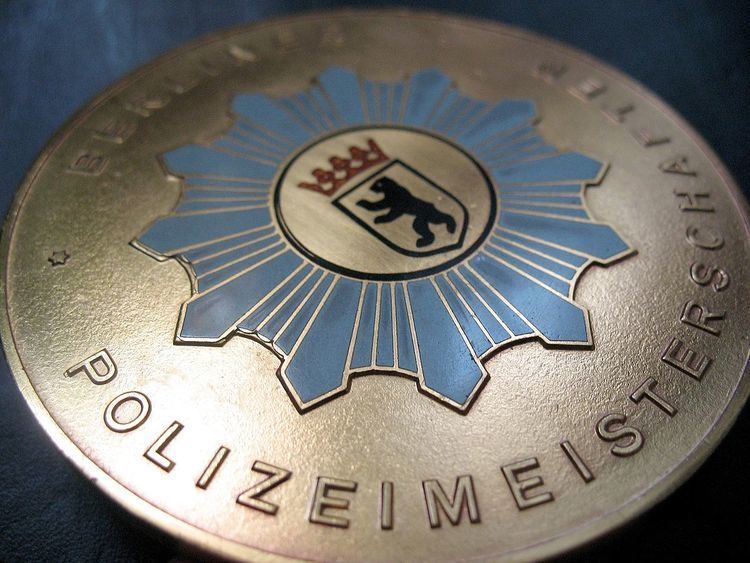Formed 23 June 1848 Size 891.85 km² | Employees 22,000 Population 3,479,740 | |
 | ||
Legal personality Governmental: Government agency | ||
The Berlin Police (German: Der Polizeipräsident in Berlin -The Police Chief of Berlin-, or commonly Berliner Polizei) is the German Landespolizei force for the city-state of Berlin. Law enforcement in Germany is divided between federal and state (Land) agencies.
Contents
The Berlin Police is headed by the Police President Klaus Kandt. His deputy is Police Vice-President Margarete Koppers. They are supported in the management of the force by the Staff Office of the Police President, the Commanders of the six Local Divisions, the Division for Central Tasks, the Criminal Investigation Department and the Central Services Division.
History
The „Royal Prussian Police“ was founded in 1809.
In March 1848 Berlin was one of the places were the Revolution of 1848 took place (also called the March Revolution). At this time just a small number of police officers (approx. 200 officers for 400,000 citizens) with limited authority, the so-called Revierpolizei (literally police station police) existed. To fight the revolution, the chief of police, police commissioner Dr. Julius Freiher von Minutoli asked the Prussian army for help. They send two guard cavallery regiments (the Regiment Gardes du Corps (cuirassiers), the 1. Garde-Dragoner Regiment "Königin Victoria von Großbritannien und Irland" (dragoons)), and three guard infantry regiments (1. and 2. Garderegiment zu Fuss, Kaiser Alexander Garde-Grenadier-Regiment Nr.1). Approximately 230 citizens were shot or killed by saber because the guard troops had the order "Immer feste druff!" (~ strike them hard). After a couple of days the troops withdrew and a militia ("Bürgerwehr") with a strength of 20,000 men was founded. In short, the militia was worthless.
Shortly after the revolution, King Frederick William IV of Prussia founded the "Königliche Schutzmannschaft zu Berlin" in June 1848. It was the first modern police force in Germany from the viewpoint of then and today. It consisted of 1 Oberst (colonel), 5 Hauptleuten (captains), 200 Wachtmeister (sergeants) and 1,800 Schutzleute (officers), 40 of them mounted.
In 1936, during the Nazi regime it was dissolved like all other German police forces, and absorbed into the Ordnungspolizei or Orpo. The Orpo was established as a centralized organisation uniting the municipal, city, and rural uniformed forces that had been organised on a state-by-state basis. Eventually the Orpo embraced virtually all of the Third Reich's law-enforcement and emergency response organizations, including fire brigades, coast guard, civil defense, and even night watchmen. It was under the overall command of Heinrich Himmler.
After the fall of the Berlin Wall (1989) and the Reunification of Germany (1990), the West Berlin police, with 20,000 employees, and the East Berlin police, with 12,000 employees; were merged under the direction of the western police chief Georg Schertz. Approximately 2,300 officers changed from the West to the East and approximately 2,700 from the East to the West. 9,600 East Berlin officers were checked to be possible collaborators of the MfS (Stasi). 8,544 of them got a recommendation, 1,056 not. Approximately 2,000 were retired or resigned themselves.
The law on the Freiwillige Polizei-Reserve Berlin (FPR): (volunteer police reserve) of 25 May 1961, in West Berlin, created a paramilitary organization to protect important infrastructure like power plants and drinking water supply f.e., Since the eighties it became more and more a branch in which citizens were able to voluntarily committed to the safety of their city as they were able to support the Schupo in daily service. It was Disbanded in 2002.
Police chiefs
This is a list of police chiefs from 1945:
Directorates
Berlin Police is divided into 6 local directorates (Direktion). Each local directorate is responsible for one to three Berliner districts:
Each Direktion had a couple of Abschnitte (precincts, all in all 38) where the patrol car staff (Schutzpolizei/Schupo) is located. Other sub departments of a Direktion are (not all listed):
Workforce
Units
Dedicated to the LKA:
The directorate central operations has the following sub branches:
